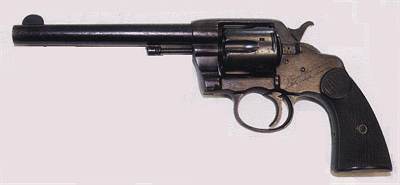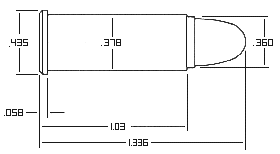 |
|
Theodore Roosevelt's M1895 Revolver |
|
|
|
Inscription on side plate |
This page is provided for those aficionados of Theodore Roosevelt who are interested in the arms issued and used by US forces and the Rough Riders during the Spanish American War. While it is not a complete history, this page will provide a good basic reference on the Colt .38 caliber revolver and its ammunition.
Missing or unknown data is marked as "n/a." If you can supply any of the missing data please email me by clicking here.
| The Pistol | The Ammunition | Ballistics |
The .38 caliber M1889/M1895 Colt revolver was the forerunner of the modern large frame swing-out cylinder revolver. Effectively the same pistol was also listed as the M1892/1894 Army Revolver.
It was the issue sidearm for US Navy personnel during the Spanish American War although it did see some service with Army troops. It was originally developed to replace the 1851 cap-and-ball revolvers that had been converted to center fire in 1887 and approximately 5000 were produced.
Chambered for the under powered.38 Colt Long and the even less powerful .38 Colt Short cartridges (which were interchangeable), the original M1889 revolver suffered from several design flaws including weak springs and latches, and a very poor cylinder indexing system which led to frequent misfires. Between 1895 and 1900 most of these pistols were returned to Colt for modifications to correct the deficiencies resulting in the "M1895" designation pistols. These pistols had a 1:18 twist with a bore diameter of .363 to .369. The model was replaced in 1908 with the vastly improved (but still under powered) .38 Special caliber M1908 revolver.
The M1889/1895 revolvers saw action in the Spanish American War, the Boxer Rebellion, and the Philippine Insurrection where its very poor incapacitation ability ("stopping power") against the Moro guerillas led to its being replaced in general issue by the 1873 Colt Single Action Army pistols in .45 Colt.
Theodore Roosevelt carried an 1895 version of this pistol, recovered from the battleship Maine, in Cuba (not a Colt 1873 as typical in the movies). His 1895 Colt was on display at Sagamore Hill and was stolen from there in 1963, recovered and then stolen again in 1990. It was recovered in 2006 and returned to Sagamore Hill on June 14, 2006
 |
|
Theodore Roosevelt's M1895 Revolver |
|
|
|
Inscription on side plate |
| Colt M1889/1895 Revolver | ||||
| Barrel (in) |
Weight (oz) |
OAL (in) |
Adoption date | Miscellaneous |
| 6 | 33 | 11.5 | c. 1889 | Cylinder rotates CC Bbl has a 1:18 twist |
The .38 Long Colt was was a black powder centerfire cartridge and the forerunner of the .38 Special cartridge. It was originally designed as an "outside lubricated bullet round for the Navy but this was changed to the "inside lubricated" bullet in 1892 and by 1897 all production of the outside lubed design was terminated. Because of the large bore diameter--based upon the outside lubricated bullet--when the inside lubricated bullet was adopted it featured a deep cavity in its base so it would expand to fit the bore upon firing. The powder charge was originally black powder but from 1900 on it was loaded with black, semi-smokeless, or smokeless powder.
| .38 Colt Army Cartridge Basic Specifications | |
| Weight of loaded ball round | n/a |
| Cartridge Case | Brass or tinned brass. with or without a cannelure. |
| Bullet Material | 1:16 tin-lead, inside lubed with 2 groves |
| Bullet length | n/a |
| Bullet Diameter | .356-.363, nominal .357 |
| Bullet Weight | 148 gr |
| Powder Charge | Known to have been loaded with both black and smokeless (c. 1900) powder. Charge weight, 15.4 black. |
| Muzzle velocity | 755 f/s |
| Penetration | n/a |

| .38 Colt Cartridge Issued Variations | ||
| Cartridge | Identification | Miscellaneous Information |
| Ball | RN lead bullet | |
| Blank | Shellacked card wad in case mouth | Also produced with a necked case with a similar wad |
| Dummy | Tinned brass case with a knurled cannelure near base |
No primer |
The ballistics of the .38 Colt round were not very impressive, being quite similar to the current .38 Special target wadcutter loading but with a round nosed bullet. It was notorious for its lack of "stopping power." The ballistics below are typical of the cartridges performance. A line of sight of .75" is assumed as is a 25 yard zero distance. A G1 ballistic coefficient of .13 is assumed based upon contemporary bullets.
| .38 Colt Ballistics | |||
| Range | Velocity (f/s) |
Energy (ft lb) |
Trajectory (in) |
| 0 | 755 | 187 | -.75 |
| 25 | 736 | 178 | � |
| 50 | 719 | 170 | -3.3 |
As a comparison, the table below shows the Hatcher "Relative Stopping Power" index for several different rounds. While this is not an exact comparison it does help to put things in perspective.
| Cartridge | Hatcher RSP* |
| .380 ACP 95 gr JHP @ 900 | 9 |
| .38 Long Colt 148 gr LRN @ 755 | 11 |
| 9 mm 124 gr FMJ RN @ 1150 | 13 |
| 9mm 147 gr JHP @ 950 | 15 |
| .38 Special 158 gr LRN @ 790 | 13 |
| .38 Special 158 gr LSWC-HP @ 915 | 18 |
| .357 magnum 125 gr JHP @ 1400 | 20 |
| .40 S&W 180 gr JHP @ 950 | 25 |
| .45 ACP 230 gr FMJ RN@ 850 | 28 |
| .45 ACP 230 gr JHP @ 850 | 35 |
| .45 Colt 250 gr LRN @ 850 | 38 |
| .45 S&W 230 gr LRN @ 770 | 32 |
| * Modified "short form" | |
The wound profile below, of the .38 Special 158 gr lead round nose at 755 f/s, is typical of the wounds made by round nose, non deforming pistol pistol bullets. Bullets of this type usually exhibit tumbling during their travel. Depending upon conditions, the bullet may end up nose or base forward. Whether or not the bullet tumbles depends upon its center of gravity and its specific nose shape. "Round nose" bullets that have a flat on their nose tend to stay point forward and not tumble. The .38 Colt round probably would give slightly less overall penetration than shown..

Please email comments to Fr. Frog by clicking here.
References
History of Modern U.S. Military Small Arms Ammunition, Vol. I: 1880-1939, by F.W. Hackley, W.H. Woodin, & E.L. Scranton, Macmilin Co., New York, 1967
| Back to the Rough Riders Page | Back to the Theodore Roosevelt Page | Back to Fr. Frog's Home Page |
Updated 2006-08-22